X-Tool D7 Smart Diagnosis System User Manual | Operating Instructions
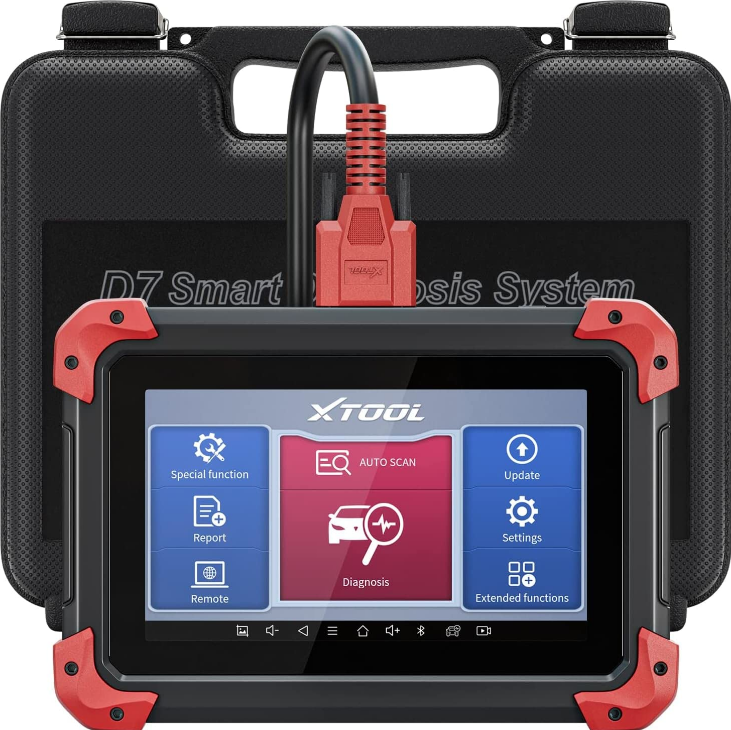
Content
Introducing the X-tool D7 Smart Diagnosis System
Cutting-edge automotive diagnostic tool the X-tool D7 Smart Diagnosis System performs complete vehicle health checks. This sophisticated equipment does OBD2 diagnostics, ECU coding, and active tests. A skilled technician is at your fingertips with the X-tool D7. It helps amateur and professional mechanics diagnose, maintain, and improve vehicle performance.
Package Kit
Main Unit
- Tablet 1 pcs
Other Accessories
- OBDⅡ-16 Connector (1 pcs)
- Used to access vehicle ECU data
- Main Test Cable (1 pcs)
- The main cable is used to connect the Tablet to the connector.
- USB Cable
- Connect display tablet to the PC or DC power adapter
- Power Adapters
- Charger DC5V AC100-300V 2A USB socket output No AC movable feet 1 pcs
- AC Charger Adapter 1 pcs (EU Standard)
- AC Charger Adapter 1 pcs (US Standard)
- Used to connect a USB cable to connect the tablet to an external DC power port for charging.
- User Manual
- Tool operation instructions
General Introduction
The XTOOL D7 smart diagnostic system is an advanced flatbed scanning tool based on the Android operating system. It supports multi-language switching and is suitable for different countries and regions. The advantage of this OBD2 scanner is not only its comprehensive functions, including complete system diagnosis, all OBD2 functions, various reset functions (IMMO / EEPROM adapter / EPB (Electronic Parking Brake) reset / oil light reset / SAS (Steering Angle Sensors) reset / TPS (Throttle Position Sensor) matching / Injector coding / ABS (Anti-block system) bleed / gearbox matching / gear learning / electronic pump actuation / disable transport mode / SRS (Supplemental Restraint System) reset / exhaust post-processing / BMS matching/air suspension/cylinder / TPMS reset/tire refit/headlight adjustment/windows Initialization/seat matching/DIY mode) can also achieve faster and more accurate diagnosis.
Tablet
The main unit of the D7 is the tablet, which has a built-in VCI module, which can be directly connected to the tablet and the car with the main test line, without the need to connect to an external VCI box via Bluetooth.
Front View of Tablet
The front of the main unit is a touchable display screen, you can use your fingers to operate on the screen to complete the car diagnosis.
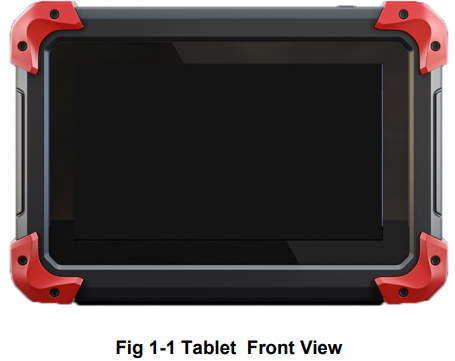
Back View of Tablet
The product model and S/N are laser-engraved on the back of the display tablet, and the small hole at the bottom is the Loudspeaker.
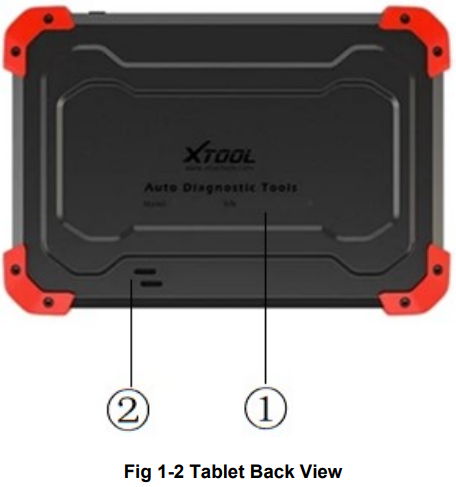
- Nameplate: Display basic information such as S/N and model etc.
- Loudspeaker: external sound can be played, supporting the playback of music, etc.
Host Ports
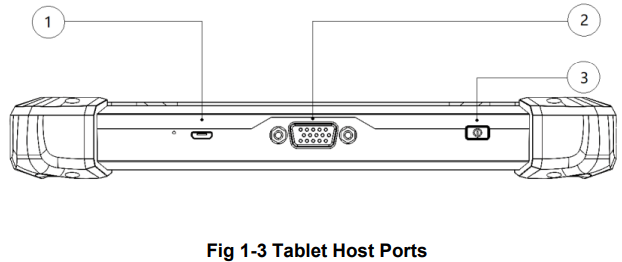
- Micro USB: Battery charge or data synchronization with PC or DC.
- DB15 Port: This port is used to connect to the main test cable.
- Power Button: Long press to power on or off. In the power-on state, short press the button to make the device enter the sleep mode.
Technical Specifications
Table 1-1 Specification
| Operating System | Android |
|---|---|
| Processor | Quad-core 1.6GHz Processor 5 |
| Memory | 32GB |
| Display | 7.0-inch touch screen with 1024×600 resolution |
| Connectivity | ⚫ USB |
| ⚫ Wi-Fi | |
| Sensors | Gravity sensor, light sensor |
| Auto Input/Output | Microphone, dual speakers, 4-band 3.5mm stereo/standard headset jack |
| Power and Battery | 4000mAh, 3.7V lithium-polymer battery |
| Power Voltage | 5V |
| Power Consumption | 8W |
| Operating Temperature | -20 to 60℃ (-4 to 140℉) |
| Storage Temperature | -40 to 70℃ (-40 to 158℉) |
| Humidity | <90% |
| Dimension (L*W*H) | 218*150*29mm |
Detailed Description
Professional automotive diagnostic tool the X-tool D7 Smart Diagnosis System simplifies diagnosis. Its easy interface lets users quickly access vehicle data, read and clear issue codes, and run active checks. D7 supports all OBD2 protocols, making it compatible with many automobiles. Even in direct sunshine, the 10.1-inch high-resolution touchscreen display is simple to see. Wireless connectivity lets users update and share data via the internet or their smartphones. For garage or travel use, the built-in rechargeable battery lasts up to 8 hours. The D7 is accessible to mechanics and vehicle enthusiasts worldwide due to its multi-language support.
Getting Started
Guide to Activation
After first-time users press and hold the power button to turn on the system, the system will automatically enter the guide process and request the user to select the system operating language.
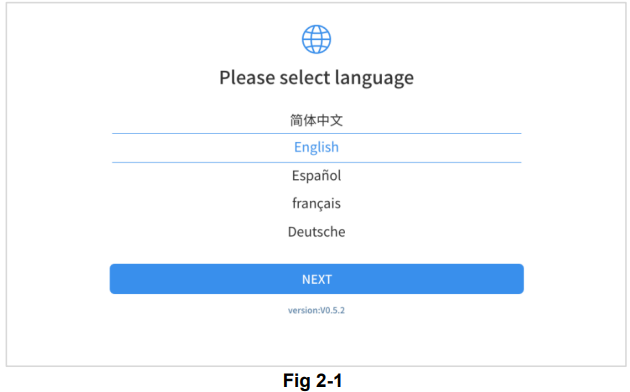
After selecting the system language, click Next to enter the Wi-Fi connection page, as shown below:

Select a network to connect to on the Wi-Fi connection page. After successful network connection, the automatic system will jump to Factory mode to download the software:
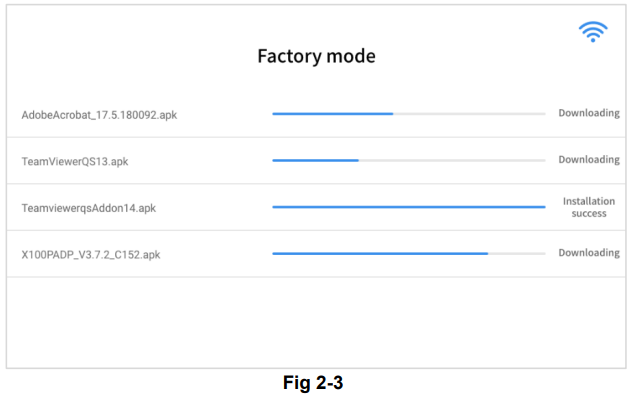
Once the software has been downloaded, the tablet will automatically reboot and request the system language selection again.
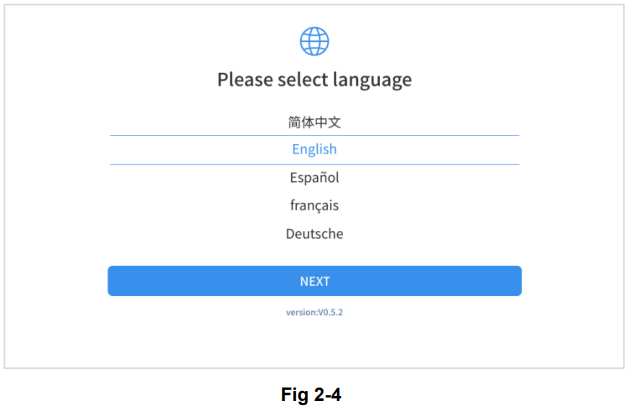
After setting the system language, you will enter the activation page, as shown in the figure below. You can also click the "Trial" button in the upper right corner to try it out before activation.
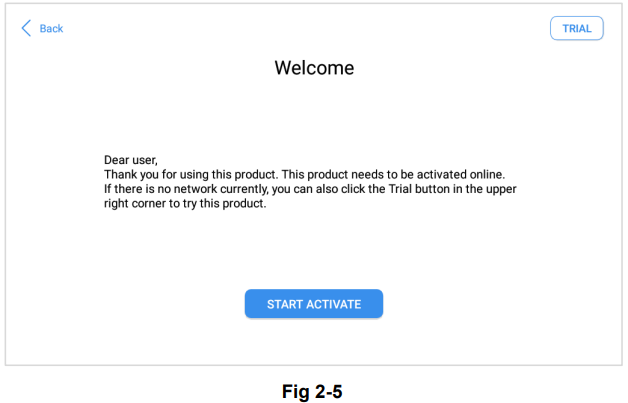
Click Start Activate to enter the activation page, as shown below:
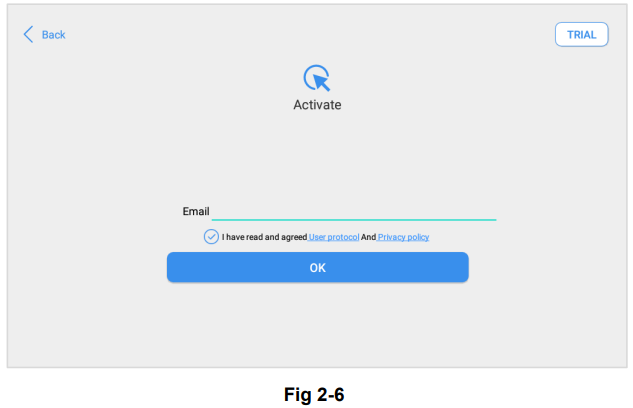
A pop-up window showing Activation Success indicates that you have completed the first boot setup, click OK to enter the diagnostic system and start using the device.
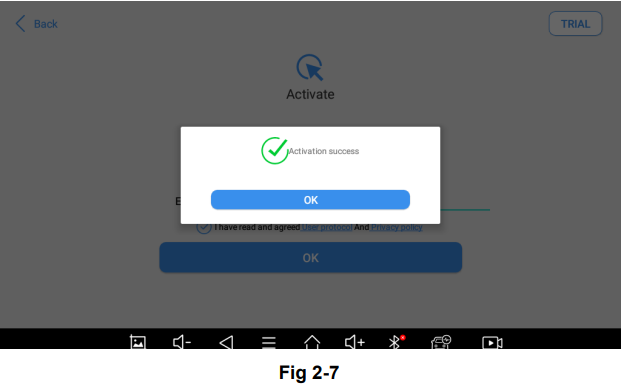
Main Interface
Operation System
As shown in the figure below, this interface is the main page of the operating system of the device. You can also return to this interface at any time by clicking 【⚪】on the bottom navigation bar.

The icons on the right, from top to bottom, are browser, photo album, application square, file manager, system settings, as shown below:
Table 2-1
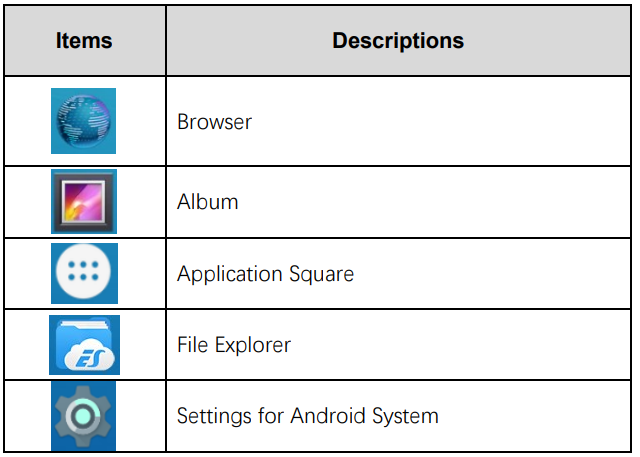
- Browser: Click on the browser icon to enter the browser to view the official website of Xtool or search for other information.
- Gallery: Click the Gallery icon to enter the album to quickly view the pictures or screenshots stored in the device. You can select the picture you need, click the share button on the upper right, and send the picture to your mobile phone or PC via Bluetooth or USB connection
Application Square: This function is suitable for power balance after replacing and repairing the cylinder. You can remove or add apps here.
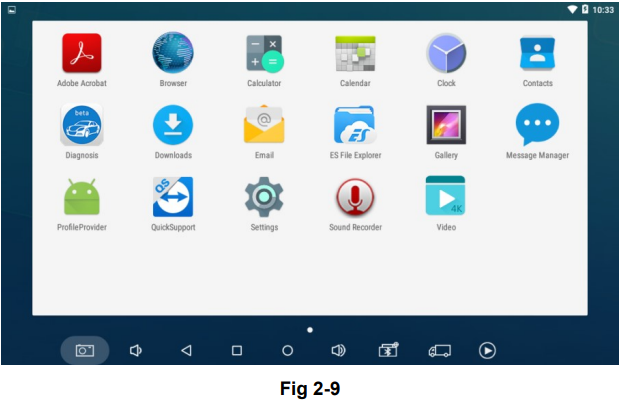
- ES File Explorer: You can manage APP, music, files, pictures, etc. in the device in this function, and you can also use Local/Home/Cleaner to clean up files.
Diagnosis System Entrance
Once activated, you will automatically enter the diagnostic system with the following main screen. Tap on the diagnosis application button on the menu, the main interface will be shown as below:
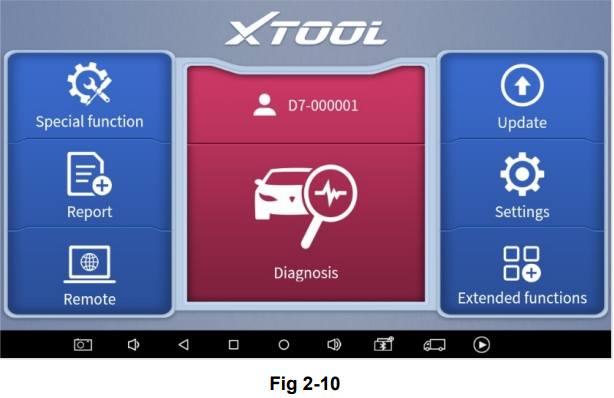
The main interface is mainly composed of Function Buttons and Navigation Buttons. The touch screen navigation is menu-driven, and you can quickly access functions by clicking on the option title and answering the dialogue window. A detailed description of the menu structure can be found in the next section Function Buttons.
Function Buttons
The following table briefly describes each function button.

Navigation Buttons
Instructions for operating the navigation bar buttons at the bottom of the screen, as described in the table below:
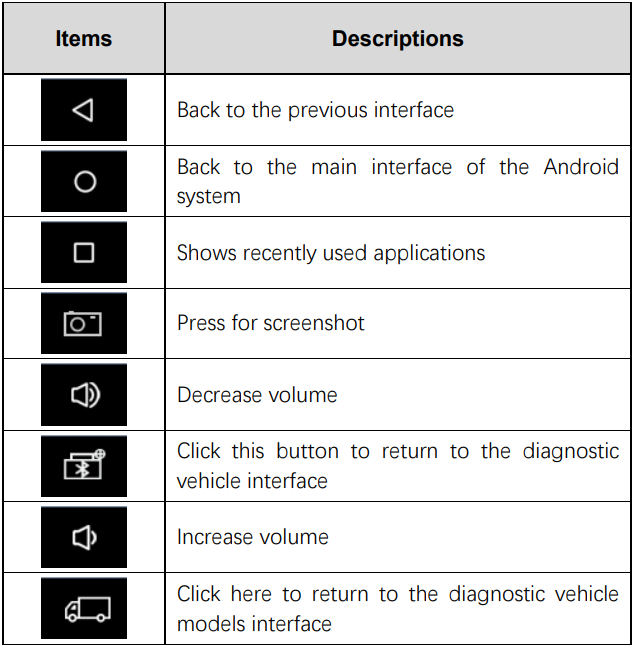
Notification Bar
Slide down to open the notification bar. Users can adjust the brightness of the screen when they need it, and you can also connect Wi-Fi and so on.
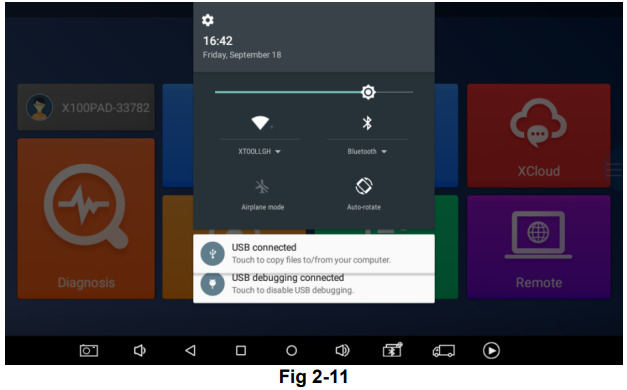
Update
After activating the device, please update the software in "Update" first. The device will pull all currently supported software packages, and you can download them as needed. ALL software updates directly via the Internet. To access the update application, open the diagnosis application and click UPDATE, shown as below:
Note: After activating the device for the first time, if you do not upgrade first, the diagnostic system will be blank.

Diagnosis
The diagnostic application can read ECU information, read and clear DTC and check living data and freeze frames. The diagnosis application can access the electronic control unit (ECU) of various vehicle control systems, including the engine, transmission, anti-lock braking system (ABS), airbag system (SRS), and perform kinds of actuation tests.
Vehicle Connection
The diagnosis operation needs to connect the D7 smart diagnosis system to a vehicle first so that the tablet can establish correct vehicle communication. Please perform the following steps:
- Turn on the tablet.
- Connect cables and tablet in the following order: ①→②→③→④;
- Switch on the ignition and tap on the Diagnosis application to test vehicles.
Since the display panel and the VCI box are integrated, to communicate with the vehicle, the OBDⅡ-16 connector must be connected to the main test cable, and the vehicle data connector should be inserted into the DLC usually located under the vehicle dashboard. The connection method is shown in the figure below:
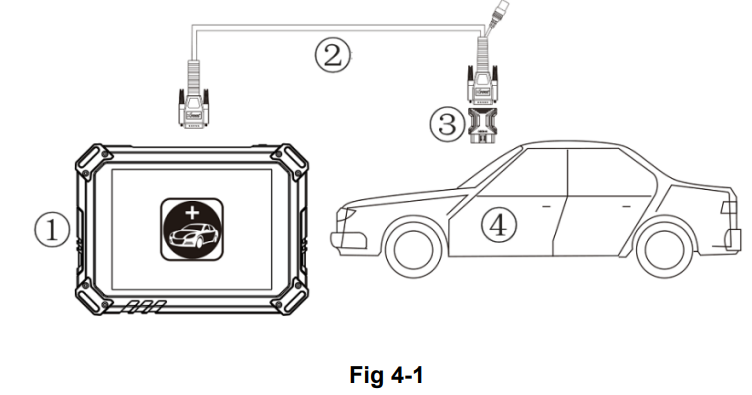
- Tablet
- Main Test Cable
- OBDII-16 Connector
- Vehicle
Caution: Please make sure all the cables are connected tightly; The vehicle’s DLC is not always located under the dash; for the location of the DLC, please refer to the vehicle’s user manual.
Diagnosis
After the tablet device is properly connected to the vehicle, the system can begin vehicle diagnosis. You can select the vehicle model that needs to be diagnosed according to the area, as shown below:
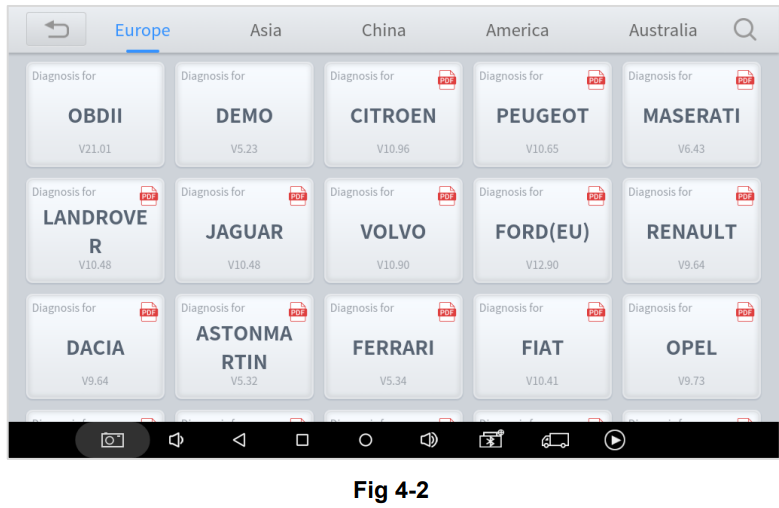
Note: OBDⅡ supports reading the common fault codes in the engine; DEMO, a demonstration program. Click this button to experience and learn the operation process of the diagnostic function.
Vehicle Selection
D7 Smart Diagnosis System support 2 ways to access the vehicle diagnosis system. You can select "Automatic Detection" or "Manual Selection" to enter the diagnosis system. Automatic detection will automatically identify the vehicle's VIN code, and then read the information of your target diagnostic object. If you choose "manual selection", then you can start the diagnosis by selecting the vehicle brand, year, and model of the vehicle. Enter "manual selection", you can also diagnose the car according to the system according to your needs after selecting the model.
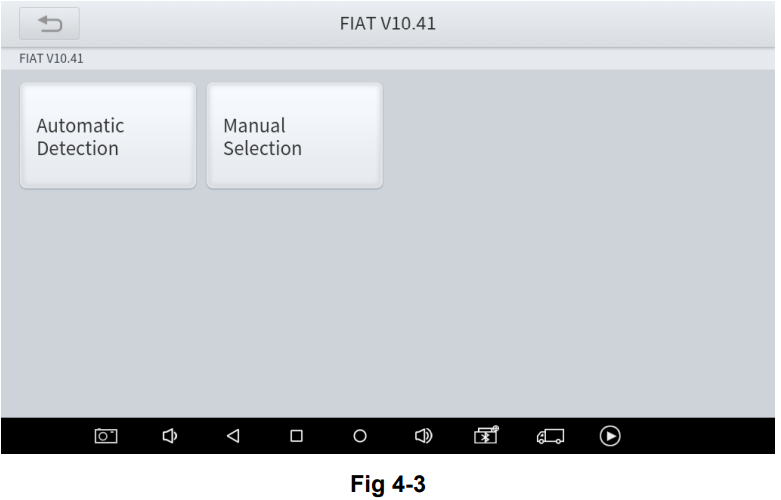
Basic Functions
The diagnosis system supports 5 basic diagnosis functions, as follows:
- Read ECU
- Read /Clear DTCs
- Read Live Data
- Actuation Test
- Freeze Frame
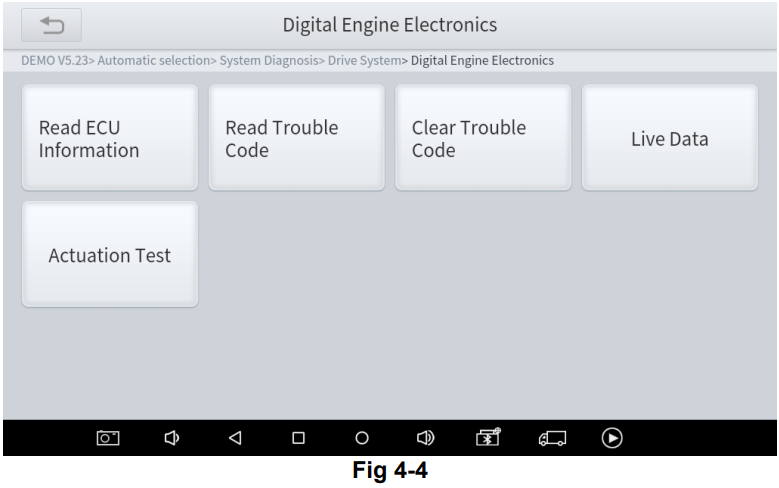
Read ECU Information: This function is to read ECU version information, which is the equivalent of "System Identification" or "System information in some electronic control systems, all mean to read ECU related software and hardware versions, models and production date of diesel engine, part number, etc. It is convenient for us to make a record in the maintenance process, and it also makes data feedback and management easier.
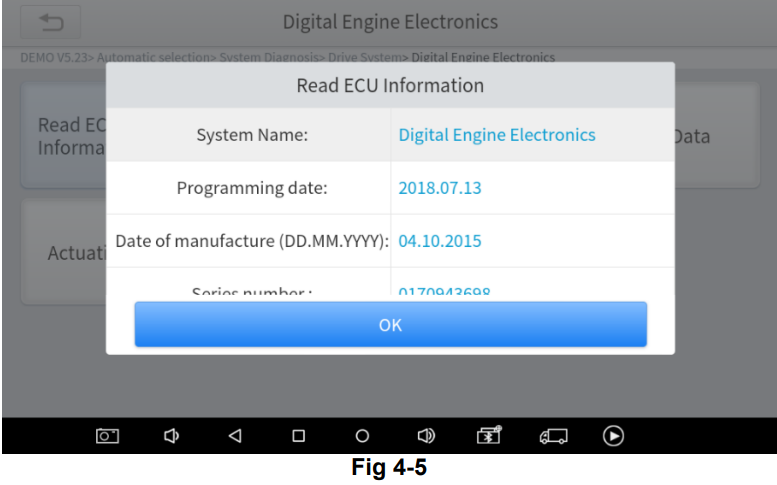
Read Trouble Code: Read trouble codes stored in ECU.

Tip: In the process of diagnosis, if the device shows “System is OK” or “No Trouble Code”, it means there is no related trouble code stored in ECU or some troubles are not under the control of ECU, most of these troubles are mechanical system troubles or executive circuit troubles, it is also possible that signal of the sensor may bias within limits, which can be judged in Live Data.
Clear Trouble Code: It allows to clear current and historical trouble codes memory in ECU, under the premise that all the troubles are eliminated.
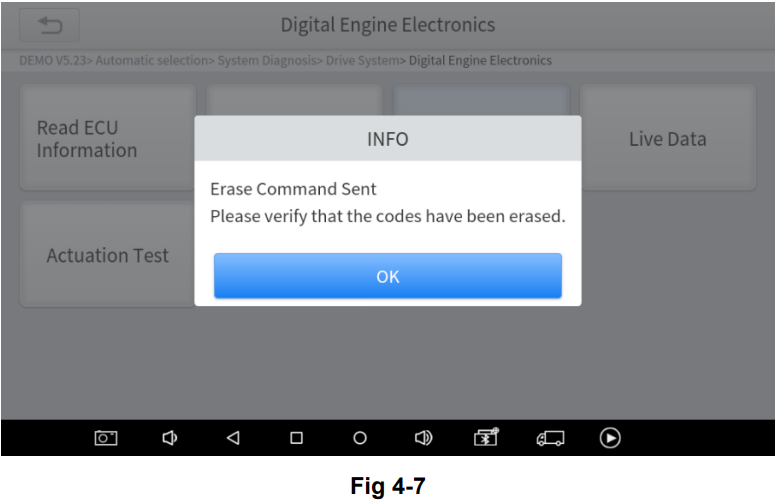
The trouble codes can’t be erased without eliminating all the troubles, which will cause the diagnostic tool to always read the trouble code because the code will always be saved in ECU.
Suggestion: users should better not clear trouble codes, we need to record the trouble details after reading the code, which is provided as a reference for maintenance. After dealing with troubles, there will be no trouble code when we re-read.
Read Live Data: That is to read the parameters of running engine, such as oil pressure, temperature, engine speed, fuel oil temperature, coolant temperature, intake air temperature, etc. Based on these parameters, we can judge directly where the problem lies, which helps to narrow the scope of maintenance. For some vehicles, during their actual operation, the problems such as performance characteristics offset, sensitivity reduction, can be judged in live data.
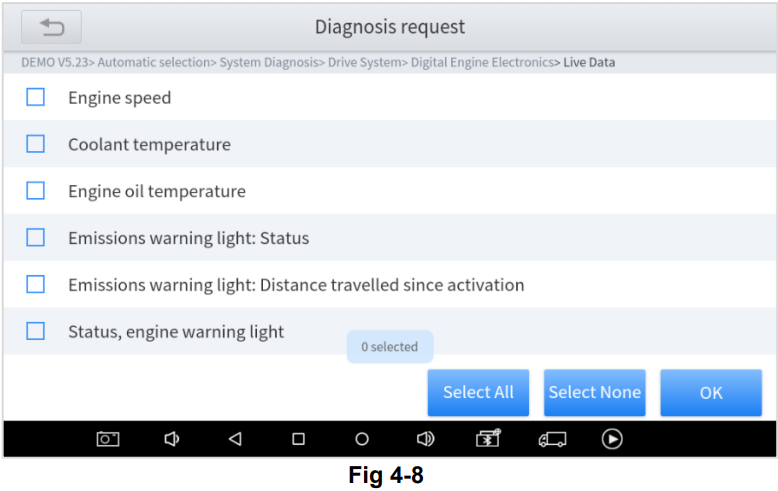
Actuation Test: Actuation test, also known as bidirectional control, is a generic term used to describe sending and receiving information between one device and another. This function is used mainly to judge whether these actuating components of the engine are working properly. The vehicle engineers responsible for designing computer control systems programmed them so a scan tool could request information or command a module to perform specific tests and functions. Some manufacturers refer to bidirectional controls as functional tests, actuator tests, inspection tests, system tests or the like. Reinitialization and reprogramming also can be included in the list of bidirectional controls. This function allows the device to send information to and receive information from, vehicle control modules. For example, in the case of OBD II generic information Mode 1 (which relates to data parameters), the scan tool user initiates a request for information from the powertrain control module (PCM), and the PCM responds by sending the information back to the scan tool for display. Most enhanced scan tools also can actuate relays, injectors and coils, perform system tests, etc. Users could check the individual part to see what is working properly by actuation test.
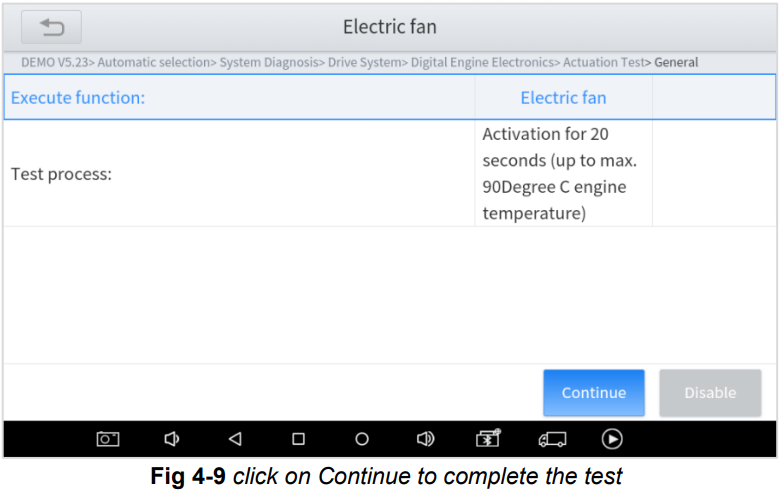
Freeze Frame: When the signal of the sensor is abnormal, the ECU will save the data at that moment of failure to form a freeze-frame. It is usually used to analyze the reasons that may lead to car failures. The living data items supported by vehicles of different brands are not the same, so the freeze frames displayed when diagnosing vehicles of different brands may also be different. Some vehicles may not have the option of a freeze-frame which means that the model does not support this function.
Special Functions
The D7 Smart Diagnosis System supports 23 commonly used special reset functions, allowing you to quickly access your vehicle system for various scheduled services, maintenance and reset performance, eliminating the need to reset after resolving common problems. This user manual lists some of the commonly used special reset services for your reference. The special functions interface is shown as below:
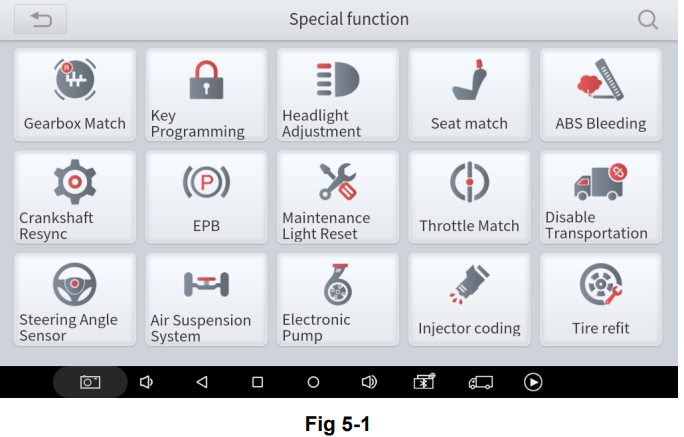
Note: Due to the limitation of screenshots, the special functions shown in this picture are not complete. All special functions supported by D7 are subject to the actual special functions displayed on the device.
Oil Reset
Reset the Engine Oil Life System, which calculates the optimum oil life change interval based on the vehicle's driving conditions and climate. The oil life reminder must be reset each time the oil is changed so that the system can calculate when the next oil change is required. This function allows you to perform a reset for the engine oil life system, which calculates an optimal oil life change interval depending on the vehicle driving conditions and climate.
This function can be performed in the following cases:
- If the service lamp is on, you must provide service for the car. After service, you need to reset the driving mileage or driving time so that the service lamp turns off and the system enables the new service cycle.
- After changing engine oil or electric appliances that monitor oil life, you need to reset the service lamp.
EPB
Electronic Parking Brake (EPB) System reset is a popular special function. You can use this function to reset the electronic parking brake system and brake pads, which also supports the brake pad replacement (retraction, release of the brake pump), G-sensor and body angle calibration. This function has multiple uses and can safely and effectively maintain the electronic brake system. These applications include deactivating and activating brake control systems, assisting in controlling brake fluid, opening and closing brake pads, and setting brakes after replacing brake discs or brake pads, etc.
- If the brake pad wears the brake pad sense line, the brake pad sense line sends a signal sense line to the onboard computer to replace the brake pad. After replacing the brake pad, you must reset the brake pad. Otherwise, the car alarms.
- Reset must be performed in the following cases:
- The brake pad and brake pad wear sensor are replaced.
- The brake pad indicator lamp is on.
- The brake pad sensor circuit is short, which is recovered.
- The servo motor is replaced.
SAS
Steering Angle Sensors (SAS) System Calibration permanently stores the current steering wheel position as the straight-ahead position in the SAS EEPROM. Therefore, the front wheels and the steering wheel must be set exactly to the straight-ahead position before calibration. In addition, the VIN is also read from the instrument cluster and stored permanently in the SAS EEPROM. On successful completion of calibration, the SAS fault memory is automatically cleared. To reset the steering angle, first find the relative zero point position for the car to drive in a straight line. Taking this position as a reference, the ECU can calculate the accurate angle for left and right steering. After replacing the steering angle position sensor, replacing steering mechanical parts (such as steering gearbox, steering column, end tie rod, steering knuckle), performing four-wheel alignment, or recovering the car body, you must reset the steering angle.
DPF
The Diesel Particle Filter (DPF) function manages DPF regeneration, DPF component replacement teach-in and DPF teach-in after replacing the engine control unit. The ECM monitors driving style and selects a suitable time to employ regeneration. Cars driven a lot at idling speed and low load will attempt to regenerate earlier than cars driven more with higher load and speed. For regeneration to take place, a prolonged high exhaust temperature must be obtained. In the event of the car being driven in such a way that regeneration is not possible, i.e., frequent short journeys, a diagnostic trouble code will eventually be registered in addition to the DPF light and “Check Engine” indicators displaying. A service regeneration can be requested in the workshop using the diagnostic tool. DPF regeneration is used to clear PM (Particulate Matter) from the DPF filter through continuous combustion oxidation mode (such as high-temperature heating combustion, fuel additive or catalyst reduce PM ignition combustion) to stabilize the filter performance.
DPF regeneration may be performed in the following cases:
- The exhaust back pressure sensor is replaced.
- The PM trap is removed or replaced.
- The fuel additive nozzle is removed or replaced.
- The catalytic oxidizer is removed or replaced.
- The DPF regeneration MIL is on and maintenance is performed.
- The DPF regeneration control module is replaced.
BMS Match
The Battery Management System (BMS) allows the scan tool to evaluate the battery charge state, monitor the close-circuit current, register the battery replacement, and activate the rest state of the vehicle. This function enables you to perform a resetting operation on the monitoring unit of the vehicle battery, in which the original low battery fault information will be cleared and battery matching will be done.
Battery matching must be performed in the following cases:
- The main battery is replaced. Battery matching must be performed to clear original low battery information and prevent the related control module from detecting false information. If the related control module detects false information, it will invalidate some electric auxiliary functions, such as automatic start & stop function, sunroof without one-key trigger function, power window without automatic function.
- Battery monitoring sensor. Battery matching is performed to re-match the control module and motoring sensor to detect battery power usage more accurately, which can avoid an error message displayed on the instrument panel.
Throttle
Throttle Position Sensor (TPS) Match, this function enables you to make initial settings to throttle actuators and returns the “learned” values stored on ECU to the default state. Doing so can accurately control the actions of regulating throttle (or idle engine) to adjust the amount of air intake.
TPMS Reset
Tire Pressure Monitor System (TPMS) Reset allows you to quickly lookup the tire sensor IDs from the vehicle ECU, as well as to perform TPMS replacement and reset procedures after tire sensors are replaced. This function allows you to quickly look up the tire sensor IDs from the vehicle’s ECU, as well as to perform TPMS replacement and sensor tests.
- After the tire pressure MIL turns on and maintenance is performed, the tire pressure resetting function must be performed to reset tire pressure and turn off the tire pressure MIL.
- Tire pressure resetting must be performed after maintenance is performed in the following cases: tire pressure is too low, tire leaks, tire pressure monitoring device is replaced or installed, the tire is replaced, the tire pressure sensor is damaged, and tire is replaced for the car with tire pressure monitoring function.
ABS Bleeding
Anti-lock Braking System (ABS) Bleeding allows you to perform various bi-directional tests to check the operating conditions of ABS.
- When the ABS contains air, the ABS bleeding function must be performed to bleed the brake system to restore ABS brake sensitivity.
- If the ABS computer, ABS pump, brake master cylinder, brake cylinder, brake line, or brake fluid is replaced, the ABS bleeding function must be performed to bleed the ABS.
- After the oil in the brake oil tank is seriously insufficient or the brake fluid is replaced, ABS Bleeding is also required.
Note:
- When performing ABS Bleeding, it is necessary to unscrew the exhaust screw of the ABS pump.
- After completing the tire pressure sensor learning, it takes a while for the fault light to go out.
- Tire pressure imbalance will also cause the tire pressure light to light up.
Injector Coding
This function can write the identification code of the fuel injector into the ECU so that the ECU can recognize and work normally. Write injector actual code or rewrite code in the ECU to the injector code of the corresponding cylinder to more accurately control or correct cylinder injection quantity. After the ECU or injector is replaced, the injector code of each cylinder must be confirmed or re-coded so that the cylinder can better identify injectors to accurately control fuel injection.
Note:
- After cleaning, generally, there is no need to do the coding matching function.
- The identification of the fuel injector includes its working accuracy value and type value. When replacing it, you need to find the corresponding model for replacement.
- At present, mainstream cars support injector coding function.
Gearbox Match
After changing the gearbox or changing the gearbox ECU, you need to use the gearbox matching function to re-match the engine and the gearbox.
Cautions: Before resetting the gearbox, please check the gearbox control unit to ensure that there is no fault code. If there is a fault code, the gearbox memory function cannot be reset. Please road test after reset.
Suspension
This function can adjust the height of the vehicle body. When replacing the body height sensor in the air suspension system, or control module or when the vehicle level is incorrect, you need to perform this function to adjust the body height sensor for level calibration. The air suspension system reset function enables the computer ECU to match the current air suspension system information, thereby ensuring the normal damping effect of the vehicle when driving.
Application Scenarios:
- The shock absorber is not the same height due to air leakage, maintenance, replacement, etc.;
- After replacing the air pump assembly;
- After replacing the control computer ECU.
Windows Initialization
This function is to match the windows to restore the initial memory of the ECU and restore the automatic raising and lowering functions of the power window. Usually, when the vehicle window fails or after replacing the window glass, we need to use this function to initialize the car window.
Seat Match
This function is suitable for the matching of replacement and maintenance seats with memory functions. After the seat fails or is replaced or repaired, it is generally necessary to use this function to match the seat.
Cautions: Needed for cars with seats with memory function, general gasoline cars don’t need.
Headlight Adjustment
Refers to the adaptive front lighting system (when using bi-xenon headlights at night), it can be rotated to both sides, pressing the button means that they stay indirect light, and will not turn when you turn the steering wheel.
IMMO Service
An immobilizer is an anti-theft mechanism that prevents a vehicle’s engine from starting unless the correct ignition key or other device is present. Most new vehicles have an immobilizer as standard equipment. An important advantage of this system is that it doesn’t require the car owner to activate it since it operates automatically. An immobilizer is considered to provide much more effective anti-theft protection than an audible alarm alone. As an anti-theft device, an immobilizer disables one of the systems needed to start a car’s engine, usually the ignition or the fuel supply. This is accomplished by radio frequency identification between a transponder in the ignition key and a device called a radio frequency reader in the steering column. When the key is placed in the ignition, the transponder sends a signal with a unique identification code to the reader, which relays it to a receiver in the vehicle’s computer control module. If the code is correct, the computer allows the fuel supply and ignition systems to operate and start the car. If the code is incorrect or absent, the computer disables the system, and the car will be unable to start until the correct key is placed in the ignition. To prevent the car from being used by unauthorized keys, the anti-theft key matching function must be performed so that the immobilizer control system on the car identifies and authorizes remote control keys to normally use the car. When the ignition switch key, ignition switch, combined instrument panel, ECU, BCM, or remote-control battery is replaced, anti-theft key matching must be performed. The IMMO service can disable a lost vehicle key and program the replacement key fob. One or more replacement key fobs can be programmed.
Note: Some models need to be used with an EEPROM adapter for IMMO service. The EEPROM adapter is not included in this product. Please purchase it separately if you need to use it.
Gear Learning
The crankshaft position sensor learns crankshaft tooth machining tolerance and saves to the computer to more accurately diagnose engine misfires. If tooth learning is not performed for a car equipped with a Delphi engine, the MIL turns on after the engine is started. The diagnostic device detects the DTC P1336 'tooth not learned'. In this case, you must use the diagnostic device to perform tooth learning for the car. After tooth learning is successful, the MIL turns off. This function can complete the self-learning of the gearbox and improve the quality of shifting. After the engine ECU, crankshaft position sensor, or crankshaft flywheel is replaced, or the DTC 'tooth not learned' is present, tooth learning must be performed.
Setup Guide
Setting up the X-tool D7 Smart Diagnosis System is easy:
- Charge the battery: Before using the D7, make sure it is fully charged. Connect the charging cable to the D7 and a power source.
- Turn on the D7: Press and hold the power button until the screen turns on.
- Connect to Wi-Fi: Select "Settings" from the home screen, then select "Wi-Fi" to connect to your home or work network.
- Register the D7: Follow the on-screen instructions to register the D7 with your x-tool account.
- Start diagnosing: Connect the D7 to your vehicle's OBD2 port and start diagnosing.
Settings
Click the Settings button to adjust the default settings and view information about the D7 Smart Diagnosis System. There are seven options available in the system settings:
- Language
- Units
- My Workshop Info
- VCI Info
- About
Language
The languages supported by this device are listed in Settings. In areas outside the English area, the default language is English and the local official language. Users can switch between English and local official languages on the device by themselves. If you need to switch other languages, please contact the dealer to unbind the current language configuration and rebind it to the language configuration you need to switch. After the configuration is successfully changed, you can switch the target language.
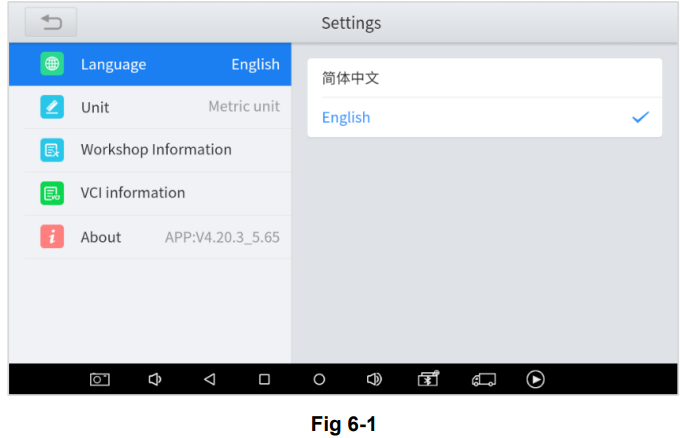
Note: This will only change the language of the APP. If you want to change the system language, please go to Android Settings.
How to change the language of your software?
- Step 1: Contact your dealer and leave a message about the language you need and the S/N of your device, The technician will modify the language configuration for you in the background.
- Step 2: Settings->Language->Choose language
- Step 3: OS Settings->Language & input->Choose Language
- Step 4: Back to Updates to pull all packages again
Note: The types and quantities of languages supported are subject to the actual language types displayed on the device.
Units
You can switch the unit used by the system. D7 Smart Diagnosis System provides you with Metric, Imperial, and U.S. units. You can directly click on the unit you need, after the switch is successful, a blue checkmark will be displayed behind the unit’s name.

My Workshop Info
Click on My Workshop Information, you can input your workshop information here. As shown in the figure below, you just need to fill in the valid information in the corresponding column and click "SUBMIT". And then it will show your workshop information in the report when you generate a diagnostic report, including your company name, address, website, telephone, and mailbox.
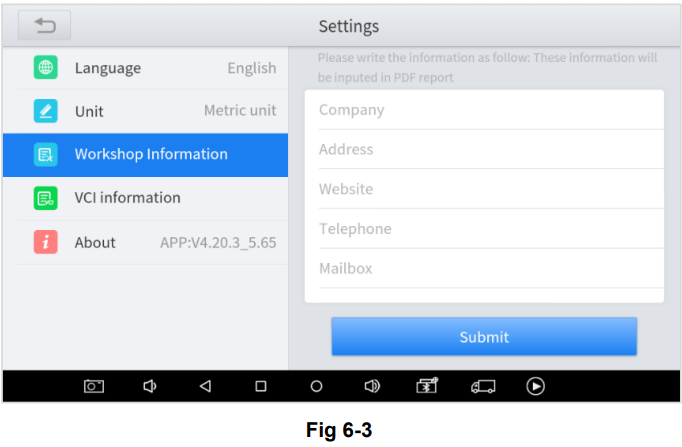
VCI Information
You can view the VCI information here, including the VCI firmware name, the latest firmware version, the currently used firmware version, and the VCI firmware type. If the current firmware version is lower than the latest firmware version, you can choose to update your firmware version and click "Update VCI Firmware" to complete the operation.
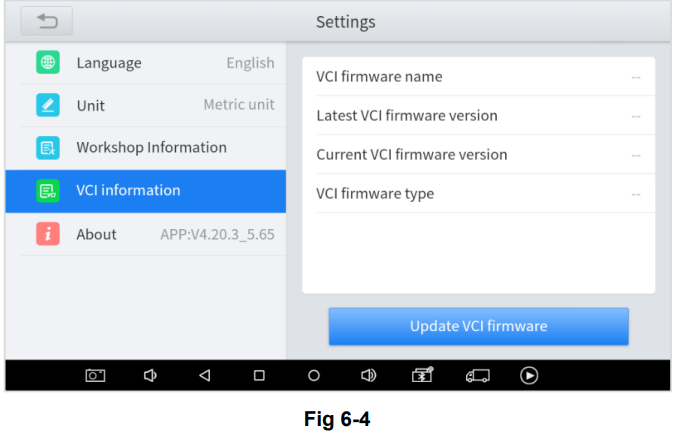
Note: Before updating the VCI Firmware, please ensure the tablet’s connection to the Internet is stable.
About
Tap on ABOUT, you can check the serial number and APP version on here.
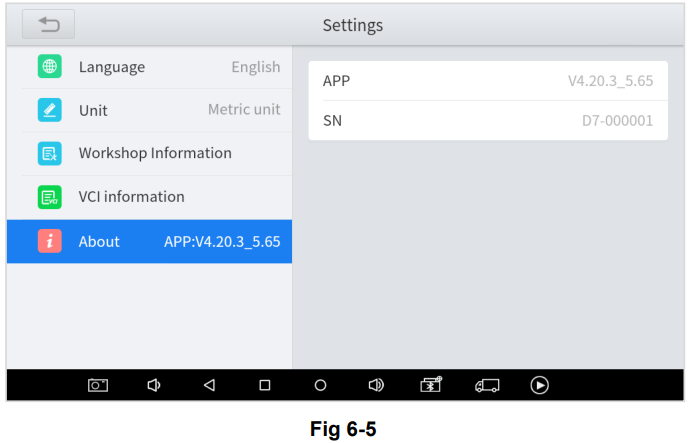
Report
Diagnostic Report is used for viewing and printing the saved files, such as Live Data, Trouble codes or pictures generated in the process of diagnosis, users also can view a record of which cars have been previously tested. It includes 3 parts:
- Report
- Replay
- File Management
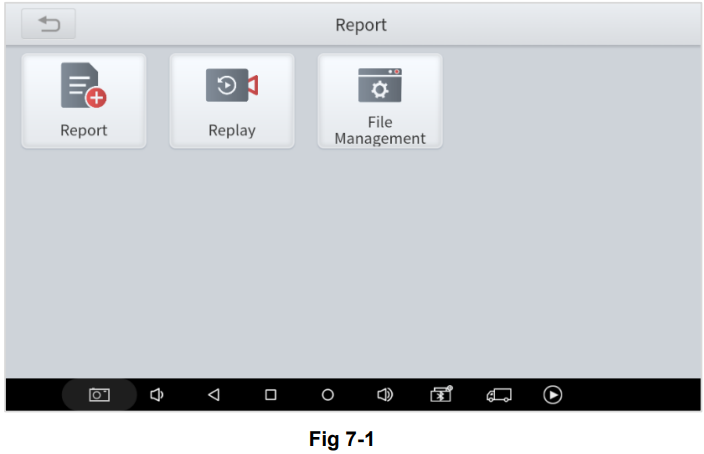
Report
This feature provides a history of diagnostic reports, where you can view and delete the vehicle's diagnostic reports according to your needs.
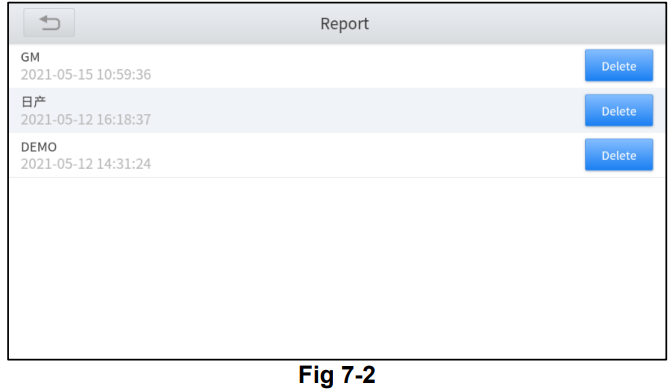
When you open the report, located in the header of the table is the studio information you filled in advance in the system setup, then the information of the vehicle, as shown as below:
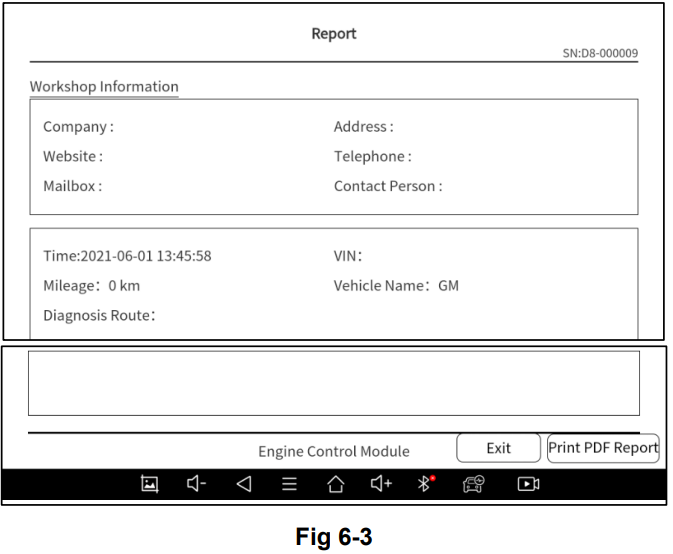
Print PDF Report
As you can see, you also could click " Print PDF Report " at the bottom right corner to output the pdf report. If you need to close the report, you could tap on the button “Exit”. Please follow the below steps to print your report:
- Install an APP that can drive your target printer. Add the printer and input the IP address of the printer in the APP, or you can contact your dealer for help.
Note: D9 PRO Smart Diagnosis System doesn’t provide the printer driver software, please install a third part App on the tablet if you need the print your diagnosis report. - Back to the Android main menu, go to Settings -> Printing-> Turn printer on.
Report-> Choose report-> Print PDF Report-> Print.
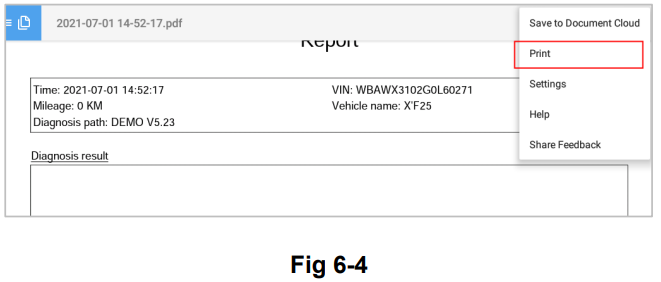
Click the top-left corner of the screen and choose the printer you added before. Then click the button on the right to print.
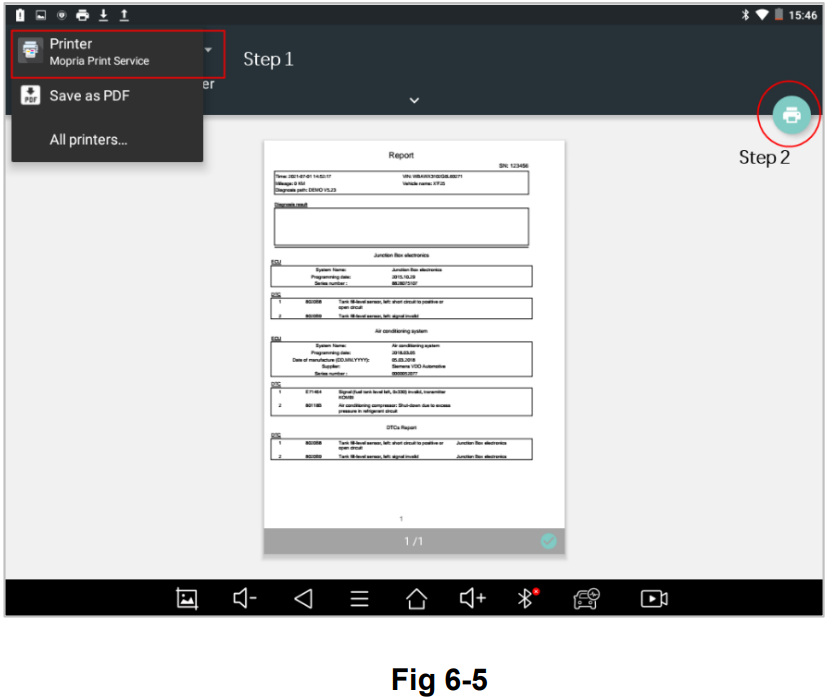
Replay
This function allows you to replay the living data recorded during the diagnosis process. Before replaying the living data, please make sure you have recorded the live data during the diagnosis.
File Manager
This function allows you to check and delete files on the device. Please use this function under the guidance of professionals. Ordinary users are not recommended to use it by themselves, as it may cause software missing or malfunctioning.
Remote Assistance
Tap on "Remote" to start the TeamViewer quick support program, which is a simple, fast, and secure remote-control screen. You can use this application to enable them to control your tablet on a PC through the TeamViewer software, thereby obtaining temporary remote support from Xtool's technical support centre. Computers and mobile devices running TeamViewer are identified by a globally unique ID. When the remote application is started for the first time, the ID will be automatically generated according to the hardware characteristics and will not be changed in the future. This TeamViewer ID can individually access all TeamViewer clients. Before launching the remote desktop application, make sure that the tablet is connected to the Internet so that you can access the tablet to receive remote support from a third party. If you encounter problems and are not able to solve them, you could open this application and ask for remote assistance.
To obtain remote support from your partners or Xtool After-service Center:
- Turn on the power of the tablet.
- Click Remote in the diagnosis application. The TeamViewer screen is displayed, and the device ID will be generated.
- Your partner must install the remote-control software on his/her computer by downloading the full version of the TeamViewer program (http://www.teamviewer.com) online, and then start the software on his/her computer at the same time, to provide support and remote control of the tablet.
- Provide your ID to the partner or Xtool technician, and then wait for him/her to send you a remote-control request.
- A pop-up window will be displayed, asking you to confirm to allow the remote-control program to control your device.
- Click Allow to accept, or click Reject to reject.
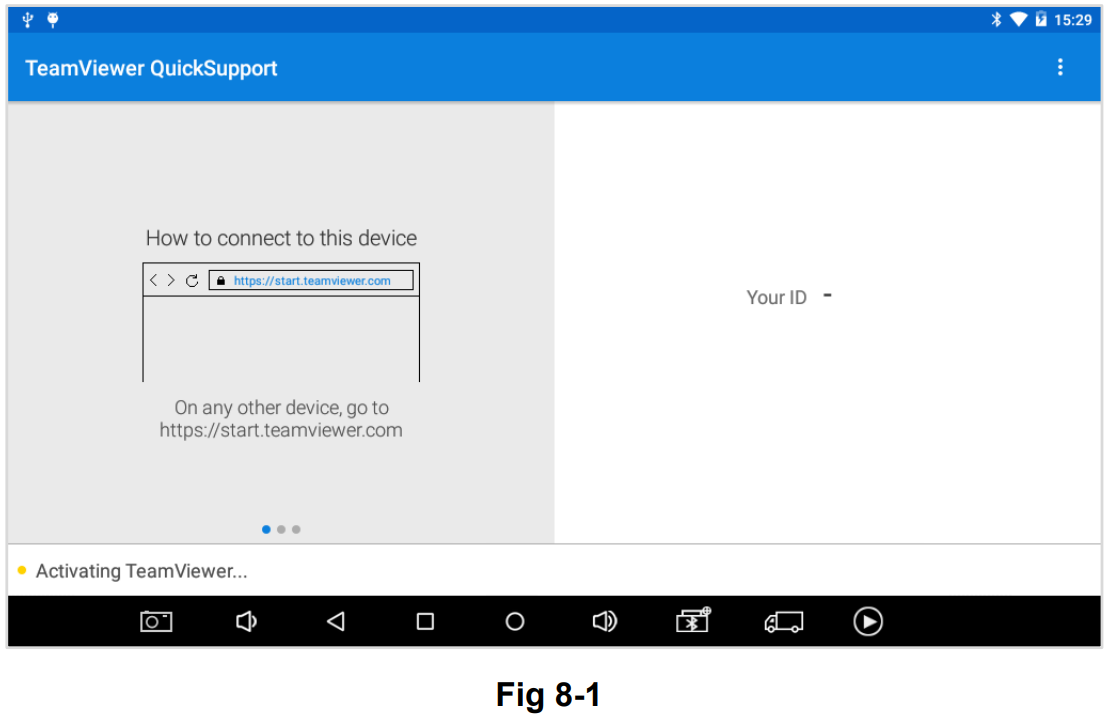
Operation Instructions
For safe operation, please follow the instructions below:
- Keep the device away from heat or fumes when you use it.
- If the vehicle battery contains acid, please keep your hands and skin or fire sources away from the battery during testing.
- The exhaust gas of the vehicle contains harmful chemicals, please ensure adequate ventilation.
- Do not touch the cooling system components or exhaust manifolds when the engine is running due to the high temperatures reached.
- Make sure the car is securely parked, Neutral is selected or the selector is at P or N position to prevent the vehicle from moving when the engine starts.
- Make sure the (DLC) diagnostic link connector is functioning properly before starting the test to avoid damage to the Diagnostic Computer.
- Do not switch off the power or unplug the connectors during testing, otherwise, you may damage the ECU and/or the Diagnostic Computer.
Cautions
- Avoid shaking or dismantling the unit as it may damage the internal components.
- Do not use hard or sharp objects to touch the LCD screen;
- Do not use excessive force;
- Do not expose the screen to strong sunlight for a long period.
- Please keep it away from water, moisture, high temperature or very low temperature.
- If necessary, calibrate the screen before testing to ensure the accuracy of LCD performance.
- Keep the main unit away from strong magnetic fields.
Troubleshooting
If you encounter any issues with the X-tool D7 Smart Diagnosis System, try the following solutions:
- Make sure the D7 is fully charged.
- Check that the D7 is connected to your vehicle's OBD2 port correctly.
- Make sure the D7 is connected to Wi-Fi and registered with your x-tool account.
- Try resetting the D7 by pressing and holding the power button for 10 seconds.
Pros & Cons
Pros
- Compatible with all OBD2 protocols
- Intuitive interface
- High-resolution touchscreen display
- Wireless connectivity options
- Built-in rechargeable battery
- Multi-language support
Cons
- Higher price point than some other diagnostic tools
- May be too advanced for casual car enthusiasts
Faqs
What is the x-tool Scanner Diagnosis?
What are the key features of the X-tool D7 Smart Diagnosis System?
What vehicles is the D7 compatible with?
How do I set up the D7?
How do I troubleshoot issues with the D7?
What are the pros and cons of the X-tool?
How do I update the software on the X-tool System?
Can I use the D7 to perform emissions tests?
What is the warranty on the D7?
How do I contact D7 System customer support?
Leave a Comment
